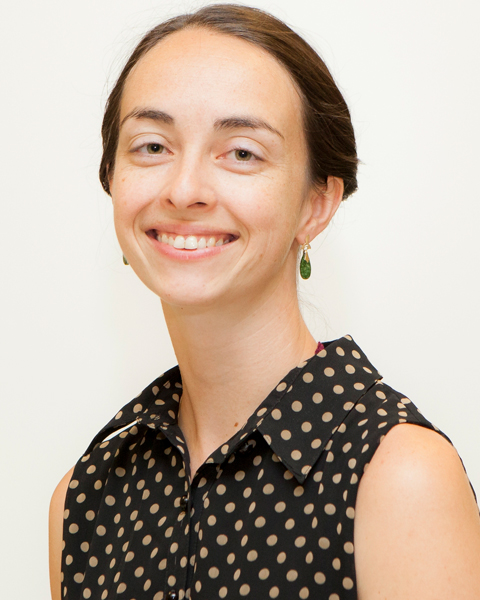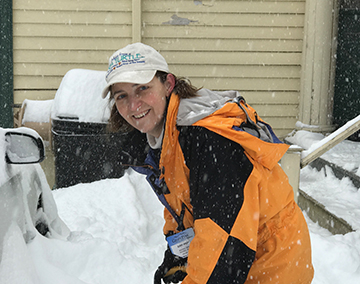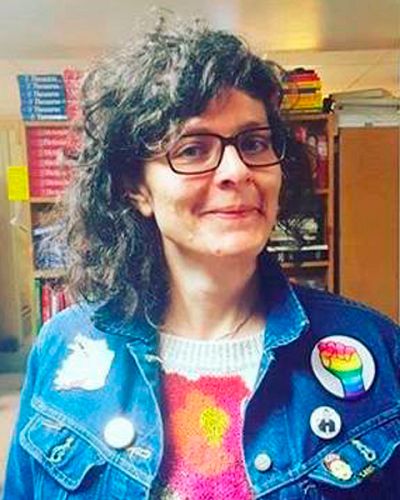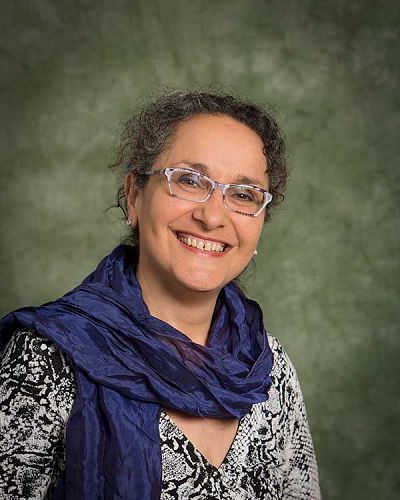Bookmaking: From Stone Tablets to E-Readers
MDVL 180A/ENG180M and MDVL 280C/ENG 280N
Bridget Whearty
One of the things that unites us as humans is how we tell stories and make records, preserving who we are and what we love. Books carry these stories–which we can learn by reading the words on their pages and also by studying them as artifacts, looking for evidence of the people who made them (and how, and why), who read and cared for them in all the years that separate us from their creators, and who preserve and share them today. This course introduces students to the unique stories that books have to tell and the field of study known as “the history of the book,” as we explore texts from the earliest forms of writing to the newest digital media. Students in this course will work closely with librarians and archivists, learning how to do original research on under-studied rare books and medieval manuscripts using Binghamton University Libraries’ Special Collections as our course “lab.”
In the fall, students will undertake an experiential learning module, building their own book. You will begin by making your own “DIY-medieval manuscript,” using the techniques we study, and then copy it into print, and finally remake it in a new digital form. This hands-on learning will help you study “from the inside out” different technologies and tools that people have used to make books throughout history. Students will also get to work, hands-ons, with two special “case study” rare books:
- a real medieval manuscript made in the midst of the first wave of the Black Plague, and
- our copy of the Nuremberg Chronicle, a gorgeous and giant book created in the first decades after the invention of movable type print in western Europe.
Working together, we will uncover these books’ secrets and tell their stories. Then, in the spring semester, you will get to choose a rare book as the center of your own study, applying what you learned in your deep dive into book history to uncover and tell its unique history.
Students in this course sequence will gain knowledge of research methods in the humanities, including specialized training in how to do hands-on research in special collections, museums, and archives. You will also learn tools for digital and information literacy; as well as ways to communicate your findings–writing, revision, and public speaking for different audiences. This course will be of particular interest to students considering majors across the humanities, fine arts, and social sciences, including Art History, Digital & Data Sciences, English, History, Medieval and Renaissance Studies, Romance Languages, and Women, Gender, and Sexuality Studies, as well as any students considering careers in education and/or libraries. Special Collections Librarian Jeremy Dibbell will be contributing to the course activities and bringing students into the world of curation of rare books in the library setting.
Read more about Dr. Whearty's research in BingUNews.
The sequence will fulfill Oral Communication (O) general education requirements in the fall and Composition (C) and Information Literacy (I) in the spring.

Bridget Whearty is an Assistant Professor at Binghamton University, in the English Department and the Medieval Studies Program. She was previously a Mellon-funded Council on Libraries and Information Resources (CLIR) Postdoctoral Fellow in Data Curation for Medieval Studies, at Stanford University Libraries. She holds a PhD from Stanford University and a BA from the University of Montana. She researches and teaches courses about medieval literatures and cultures, as well as text technologies from medieval manuscripts to digitization and the rise of the internet.
Mapping American Prejudice
HIST 180A and HIST 280A
Wendy Wall
Racial and religious prejudice are expressed through both private actions and public policies, and the targets of prejudice change across space and time. In the late 19th and early 20th centuries, Jim Crow segregation spread across the South; the federal government imposed a sweeping immigration ban targeting Chinese; and prominent intellectuals in many parts of the country embraced a pseudo-scientific hierarchy of races that placed "Nordics" above "Mediterraneans," and both above people of African and Asian descent. In the 1920s, a revived Ku Klux Klan spread from the Atlantic to the Pacific Coast, denouncing Catholics and Jews, as much as people of color. As housing tracts multiplied over the next few decades, many homebuilders used "restrictive covenants" to prevent the sale of homes to non-whites, "aliens," and occasionally groups like Italians and Jews. Many European immigrants eventually made their way into the white middle-class, and a burgeoning civil rights movement discredited the more virulent forms of racism. At the same time, however, federal "redlining" policies, urban renewal projects, and other public and private policies further entrenched structural racism.
How do the parameters of prejudice change over time? How do both private actions and public policy embed discrimination in the landscape around us? And how does structural racism continue to shape lives, even as overt expressions of intolerance fade?
This course sequence explores such questions by focusing on Broome County, New York, the home of Binghamton University, the birthplace of IBM, and an area long known as the Valley of Opportunity. In the antebellum period, Binghamton and surrounding areas were a major hub on the Underground Railroad. In the late 19th and early 20th centuries, Southern and Eastern European immigrants flocked to the area's cigar and shoe factories, and local corporations pioneered an approach known as "welfare capitalism." During the Cold War, the area's concentration of electronics firms and defense manufacturers drew high-tech workers. Yet such oft-retold stories of freedom and opportunity obscure a darker and more troubled past that is too easily forgotten. At the turn of the 21st century, Broome County was more than 90% white, in part a reflection of this history. The last two decades have seen an influx of immigrants and refugees from across the globe, and Americans of all races have come to the area for a more affordable life. Still, the historic politics of prejudice remain inscribed in various ways on the urban landscape.
How might public-facing history begin to redress both individual prejudice and structural racism by sparking civic dialogue? In the fall, students will explore these issues through a combination of reading, historical research, and community engagement. We will peruse newspapers and pamphlets produced by the KKK in the early 1920s, when Binghamton was the Klan's New York State headquarters. We will work with newly digitized deeds, locating and mapping racial covenants in Broome County. Finally, we will examine federal "redlining" maps and photographs and documents charting the path of urban renewal. Students will also learn digital and other techniques for disseminating their findings to a broader public. In the spring, students will conduct an individual research project of their design and disseminate their findings in a campus-wide poster session and through other appropriate outlets.
The sequence will fulfill Community Engaged Learning (CEL), Information Literacy (I), Social Sciences (N), Critical Thinking and Reasoning (T), and Harpur College Writing (W) general education requirements in the fall and Information Literacy (I), Social Sciences (N), Critical Thinking and Reasoning (T), and Harpur College Writing (W) in the spring.

Wendy Wall is a historian of U.S. political culture and director of the Institute for Advanced Studies in the Humanities. Her prize-winning book Inventing the "American Way": The Politics of Consensus from the New Deal to the Civil Rights Movement and numerous essays explore the intertwined issues of race, ethnicity, religion, citizenship and politics in the 20th century. A former journalist whose work has been cited in publications ranging from the New York Times to The American Prospect, she is committed to fostering conversation between those within and beyond university walls. She hopes that a deeper public understanding of history will inform and shape future policy debates.
Gender & Sexuality in Antiquity
AMS 180S/WGSS 283K and AMS 280S/WGSS 280F
Tina Chronopoulos
Our modern lives (in the North American context) are heavily gendered and sexualized. Think of the proliferation of gender reveal parties or the policing of bathrooms or how children’s toys are increasingly marketed to either girls or boys. You might also consider the saying “Men are from Mars, Women are from Venus” (the title of a book published in 1992): it implies that women are complex beings, driven by emotions and that men are practical thinkers who are driven by biology. When it comes to sexuality, most of us tend to assume that it is a natural force that can either be liberated or repressed. Yet the kinds of sexual behaviors we get to read, see, or hear about in the mainstream tend to be quite limited. Overall, the sexual norms that bind us and the sexual practices we engage in can and often do lie unexamined, not to mention that we usually give little thought to why and how gendered spheres or activities have come to exist.
What is and is not deemed socially acceptable in terms of gender expression and identity, and sexual practices varies according to where and when you look. In the ancient Mediterranean, for example, extramarital sex between a man and a (subordinate) woman is widely attested, yet women’s sexual activities were tightly controlled: on the one hand, this was an issue because of the legitimacy of heirs (in the case of families who held property or wealth), and on the other hand, this was about control in a world in which women were thought to be inferior to men. Many ancient Mediterranean funerary inscriptions praise women for their appearance and their personal qualities, yet when it comes to men, they focus almost entirely on their accomplishments. In general, women lacked political rights across the board, making exceptional figures such as Cleopatra, who famously had romantic and sexual relationships with two powerful Roman men (Julius Caesar and Mark Antony), all the more intriguing.
This course will give students a chance to explore how gender and sexuality were defined, controlled, constructed, and lived out in the past, specifically in the Ancient Mediterranean context.
During the first semester, students will encounter a number of key sources (texts, material objects) that will allow them to frame and understand historical perspectives on gender and sexuality in the ancient world. We will consider evidence from areas such as the Ancient Near East, North Africa (e.g. Carthage, Egypt, Ethiopia, Nubia), Greece and Asia Minor, and Italy and its colonies (e.g. Britain, France, Germany, Spain). During the second semester of the course, students will identify and pursue their own research projects related to gender and sexuality in an ancient culture that is of interest to them (either in the areas covered in the course or in other areas from around the globe). Students will also have a chance to collaborate on putting together an exhibition to be displayed in the Bartle Library lobby using holdings from the University Library.
The sequence will fulfill Global Interdependencies (G), Humanities (H), Information Literacy (I), and Oral Communication (O) general education requirements in the fall and Global Interdependencies (G), Humanities (H), and Composition (C) in the spring.

Tina Chronopoulos is a British-infused Greco-German transplant whose research and teaching interests range all over the Mediterranean and span more than a millennium, from Greco-Roman antiquity to the medieval period and beyond. Trained by old-school philologists, she enjoys deep dives into libraries and archives, as well as close readings of texts, contexts, and medieval manuscripts. In the classroom, she gets excited about speaking in Latin as much as possible and encouraging her students to read both the past and the present contextually whilst wearing the lenses of race, class, and gender.
People, Politics and the Environment
PLSC 180A and PLSC 180B
Robert A. Holahan
Societies emerge and develop to take advantage of the natural and engineered environments that define their landscapes. This can be a local process but is also inescapably tied to global dynamics in which social, ecological, economic, and environmental interact to create new understandings of what it means to be a person living in a place in a time. We will develop an approach to studying the place you are as a new college student—Binghamton—as an example of the broader processes at work in local social-ecological systems. You will practice a variety of research methods from the social sciences and environmental science to demonstrate the need to integrate perspectives and approaches when studying the relationship among people, places, and the environment.
The sequence will fulfill Social Sciences (N) and Critical Thinking and Reasoning (T) in the fall and Community Engaged Learning (CEL) and Joint Composition and Oral Communication (J) in the spring.

Robert Holahan is an associate professor of environmental studies and political science
and director of the Dickinson Research Team (DiRT). DiRT is a residential community-based
research program that is the first of its kind in the United States. DiRT is open
to students who are interested in research, regardless of major and prior research
experience.
Living in a Material World: The Stuff of Memory and the Pursuit of History
(Previously titled The Stuff of Memory: History, the City and Everyday Things)
YIDD 180A/JUST 180C/HIST 180B and YIDD 280A/JUST 284A
Gina Glasman
This class will be dedicated to a single question: how can we use the artefacts of everyday life to better understand the history of an immigrant metropolis? To explore this question, we will focus on a specific city—New York—and a particular cultural vehicle, museums—institutions rooted in the notion that “objects” can speak! In the Spring semester, students will create their own digital exhibit, using the themes, approaches and concepts we have explored together in class. Students can choose to focus their research on any community within the complex urban fabric of either past or present-day New York City.
To help us with this task, we will divide our study into several parts. We will begin with the earliest efforts by historians—often Marxist inflected - to chart the lives of “everyday people.” This approach was sometimes twinned with a new interest in the material world. From there, we will take a look at recent histories of the immigrant city, with a focus on Jewish, or Yiddish immigrant New York in the early twentieth century. Here too, we will find a focus on ordinary things, as part of the investigation of the urban landscape—from a discarded candy wrapper in the street, to the latest cut in city fashion. Recorded memory - or oral history - is also key to this kind of analysis, as a way to access the culture of everyday life. Finally, students will research, design and mount a digital exhibit of their own creation, based on the questions addressed in class. In preparation for this project, we will also consider the uses of material culture in the work of social history museums, as well as comparable initiatives in the fields of anthropology and public archaeology.
The sequence will fulfill Joint Composition and Oral Communication (J) and Social Sciences (N) general education requirements in the fall and Joint Composition and Oral Communication (J) in the spring.

Gina Glasman is a London born American immigrant, now resident in Binghamton, New York. She has had a life-long interest in the study of Yiddish society and its urban culture, that has roots in her own biography, as the grandchild of Yiddish speaking immigrants to London. Her current work, both in the classroom and beyond, often seeks to bind together forms of personal engagement with scholarly research and encourages students to do the same—whether they are learning Yiddish language, or immersing themselves in the long, rich and sometimes tragic story of this distinctive diasporic minority.
Debating Basic Income
PHIL 180A/ENG 180N/ECON 181A and PHIL 280A/ENG 280N/ECON 181B
Will Glovinsky
In the past decade, the idea that governments should give people regular, unconditional cash payments has become an unexpectedly mainstream policy proposal. From Switzerland to Stockton to Kenya, pilot programs and campaigns for universal basic income have made headlines at a time of mounting uncertainty about the future of work in an age of automation and artificial intelligence. What is less well known is that the idea of basic income has been robustly debated for 250 years. In this research stream, students will approach the concept of “income for all” from philosophical, economic, literary, historical, and public policy perspectives. Our premise will be that we cannot rigorously evaluate the potential effects of this compelling yet controversial idea without understanding where it comes from, how it has been argued for, and why it has repeatedly captured imaginations over centuries.
In the fall, students will explore primary sources related to the origins and development of basic income. We will begin by immersing ourselves in the circle of late-eighteenth-century English ultraradicals led by Thomas Spence, who first proposed an economic system in which individuals will rent land from parish governments rather than private landlords, with the rental income then distributed equally to all residents, male and female, as a regular cash dividend. Students will examine Spence’s philosophical milieu as well as the strikingly literary quality of his writings, which include a sequel to Robinson Crusoe where the islanders implement a basic income and ballads sung in taverns to spread his views among the London working class. Since these radical ideas were inspired by colonial accounts of Indigenous resource sharing, students will then turn to Lahontan’s 1703 Dialogue with a Savage (adapted from conversations with the Wyandot diplomat Kandiaronk) to trace the transatlantic intellectual exchanges that contributed to Enlightenment egalitarianism. Later units will focus on documents relating to the Jamaican abolitionist Robert Wedderburn, Henry George’s “single tax” movement, Martin Luther King, Jr.’s writings on guaranteed income, Juliet Rhys-Williams and Milton Friedman’s “negative income tax”, and the Canadian “Mincome” experiment run during the 1970s. Over the semester, students will gain skills in using close textual analysis to ask questions about historical documents while also locating individual works within broader intellectual genealogies. Our guiding questions will examine how the divergent philosophical premises—ranging from socialism to neoliberalism—underlying basic income proposals have shaped their structures, justifications, and popular receptions. Is basic income a political entitlement or something owed to people as a natural right? How would it be funded, and who would be eligible? What would be its effects on labor, family, and the environment?
In the spring, students will select a subset of disciplinary methods and formulate a research project that explores one chapter in the history of basic income. A series of workshops will introduce students to both archival resources and digital databases, and they will present their works-in-progress throughout the semester. As part of their final projects, students will publish from their findings by curating an entry in a multimedia digital timeline providing accessible histories and analyses of basic income’s sources.
The sequence will fulfill Humanities (H), Information Literacy (I), Critical Thinking and Reasoning (T), and Harpur College Writing (W) general education requirements in the fall and Oral Communication (O) and Harpur College Writing (W) in the spring.
Empathy, Ethics, and Society
PHIL 180B/ENG 180O and PHIL 280B/ENG 280O
Will Glovinsky
From empaths and “highly sensitive person” TikTok to social justice movements and studies in psychology and moral philosophy, claims about the powers and perils of empathy are ubiquitous in contemporary life. The ability to share someone else’s feelings and see the world from their perspective can, according to various authorities, make us better partners, friends, doctors, managers, and citizens. Yet the valorization of empathy has also been blamed for licensing cultures of voyeurism in war reporting and social media, flattering the egos of privileged spectators, and inflaming social tensions with misguided conceptions of other peoples’ cultures. Empathy is hailed as a defining human trait, yet bonobos may beat us at it. This research stream will invite students to pull back the curtain on an everyday concept and consider it through the disciplinary insights of moral philosophy, literature, psychology, neuroscience, evolutionary biology, the medical humanities, and journalism. We will ask what empathy really is (a matter of considerable debate), what its psychological basis involves, and what it can—and can’t—do for us.
The fall semester will introduce students to how empathy has been understood and applied across a variety of disciplines. We will begin with primatologist Frans de Waal’s writings on empathy in animals and then survey what evolutionary psychology and studies of our brains’ “mirror neurons” can tell us about feeling with and for others. Next, we will delve into historical accounts of empathy (and its related forerunner, sympathy). After reading Enlightenment theories of fellow-feeling by Adam Smith and David Hume, we will consider the case study of nineteenth-century US slave narratives, which consciously deployed sentimental scenes to mobilize white readers—a tactic whose ramifications have been scrutinized by contemporary scholars. We will then explore the emergence of the German aesthetic concept of Einfühlung, which was imported into English as “empathy” around 1910 by the literary theorist and ghost-story writer Vernon Lee. The last two units will focus on empathy’s uses and abuses. First, we will analyze Martha Nussbaum’s brief for the political utility of empathy, while readings in narrative medicine, bioethics, and business will introduce students to the growing role of empathy in medical training and management. Finally, we will consider two complex critiques of empathy: Octavia Butler’s Parable of the Sower, a chilling work of speculative fiction about empathy without limits, and Susan Sontag’s criticism of conflict photography’s claims to raise consciousness of current events.
By the end of the fall semester, students will use one of the methodologies we have discussed to design a research agenda culminating in a capstone project. We will work in small groups to narrow down topics and revise research questions and then meet over the course of the spring to workshop ideas, set goals, and revise written work. Students will present their projects in campus-wide poster sessions and other multimedia forums.
The sequence will fulfill Humanities (H), Information Literacy (I), Critical Thinking and Reasoning (T), and Harpur College Writing (W) general education requirements in the fall and Oral Communication (O) and Harpur College Writing (W) in the spring.

Will Glovinsky is a Visiting Assistant Professor of Humanities. Before arriving at Binghamton, he was a lecturer in English and Comparative Literature at Columbia University, where he received his PhD. A specialist in 19th-century British literature, he is revising his first book on the regulation of feeling in realist novels and imperial culture. His next project explores how the idea of universal basic income—or giving cash regularly to everyone—emerged in 18th- and 19th-century tavern ballads, dialogues, essays, and novels. In between, his essays and courses have explored topics such as narrators who regret their treatment of villains, the role of liberation in the novel, and the history of close reading.